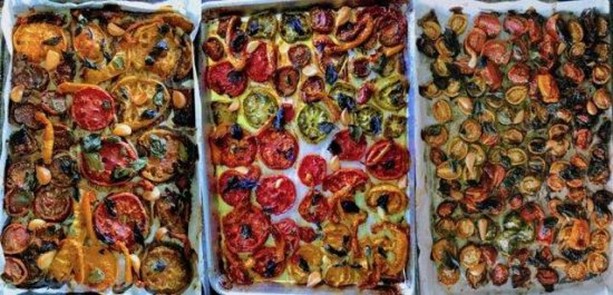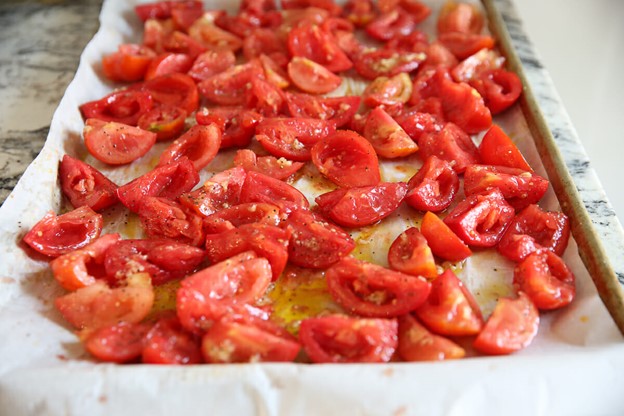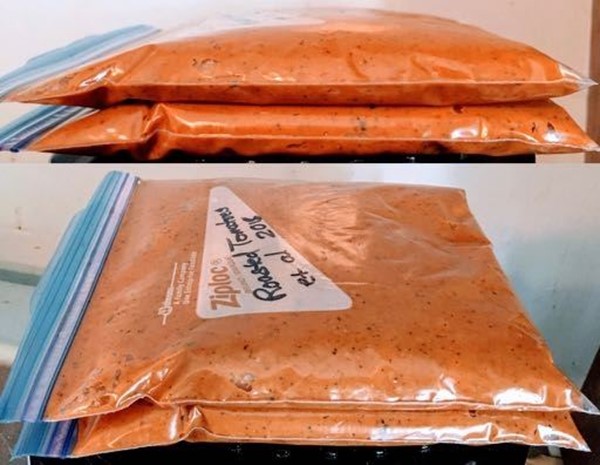A New and WAY BETTER WAY to Make Tomato Sauce!
I know it’s not tomato season. But you might want to know about this tomato preservation technique so you can plan for it now. Also, if you happen to run onto a super sale on tomatoes (which happens sometimes when the produce manager needs to move an aging supply quickly), then you’re gonna love this idea!

I’m talking about ROASTING tomatoes as part of making home canned tomato sauces and marinaras. I followed this procedure this past summer, and the results have been non-stop fantastic. Roasting any vegetable increases its depth of flavor, so roasting tomatoes before home canning or freezing them makes good sense.
When roasting, you want like-sized tomatoes spread over your sheet pan. So if you need to, just cut your tomatoes into similar sizes. Different sizes will roast for variable amounts of time, so the more even the pieces, the better. Larger tomatoes need to be sliced thickly or quartered and cored. And by the way, you can even use cherry or pear tomatoes in this process.

Line rimmed sheet pans with parchment paper and lightly coat these with olive oil prior to loading the pans with tomatoes. Then place garlic cloves, fresh basil leaves, and bell pepper pieces throughout the arrangement of tomatoes. There is no recipe to follow. It’s all about personal preference.
Be sure not to pile your tomatoes atop each other. They won’t roast evenly if you do. They can certainly touch, but try to keep them from overlapping.
Rimmed sheet pans are best to use because you’re going to liberally drizzle olive oil over the top of the veggies. The tomatoes will also bleed some of their moisture onto the surface as they cook down. Without a high enough edge, that liquid will end up all over the bottom of your oven.

Roast them for 3-4 hours at 275 degrees. (You’ll notice how heavenly they smell as they roast.) It you have smaller pieces that are already caramelized, remove them and then turn up the temperature to 325 degrees for the larger tomatoes. Once finished, remove the trays from the oven and let them cool.
Once cooled, slide the roasted vegetables into your blender or food processor. Pulse-puree until you have the texture of sauce you want. From here you can either can (using a water bath or a pressure cooker), or freeze your sauce.
The only negative thing I have to say about this process is the loss in quantity. Three trays of lush tomatoes (around 15 pounds) yielded just two partially filled quart bags for freezing. But still, the incredible rich, roasted flavor of this sauce is absolutely worth it.

And you have to love that the oven is doing the bulk of the work rather than you slaving over a hot stove while creating your end product. I also love that the vitamin-loaded skins are included in the end product. The jury is in, and the verdict? This is a WAY BETTER method of making tomato sauce!
And I’ll close by sharing a crowd-pleasing application of this roasted tomato sauce. We heat ours through then swirl pesto sauce into it before pouring it over pasta. The proportions are 3 cups sauce to ¾ to 1 cup pesto sauce (it depends on how much you like pesto).

And by the way, this sauce (with or without the added pesto) is simply divine over lightly steamed spiralized veggies (zucchini or sweet potatoes, especially). Add a sprinkling of roughly chopped walnuts or pine nuts and you have a winner every time. Or layer pesto atop your roasted tomato sauce when making homemade pizza before adding other roasted veggies and you’ll have yet another winner!

I’m talking about ROASTING tomatoes as part of making home canned tomato sauces and marinaras. I followed this procedure this past summer, and the results have been non-stop fantastic. Roasting any vegetable increases its depth of flavor, so roasting tomatoes before home canning or freezing them makes good sense.
When roasting, you want like-sized tomatoes spread over your sheet pan. So if you need to, just cut your tomatoes into similar sizes. Different sizes will roast for variable amounts of time, so the more even the pieces, the better. Larger tomatoes need to be sliced thickly or quartered and cored. And by the way, you can even use cherry or pear tomatoes in this process.

Line rimmed sheet pans with parchment paper and lightly coat these with olive oil prior to loading the pans with tomatoes. Then place garlic cloves, fresh basil leaves, and bell pepper pieces throughout the arrangement of tomatoes. There is no recipe to follow. It’s all about personal preference.
Be sure not to pile your tomatoes atop each other. They won’t roast evenly if you do. They can certainly touch, but try to keep them from overlapping.
Rimmed sheet pans are best to use because you’re going to liberally drizzle olive oil over the top of the veggies. The tomatoes will also bleed some of their moisture onto the surface as they cook down. Without a high enough edge, that liquid will end up all over the bottom of your oven.

Roast them for 3-4 hours at 275 degrees. (You’ll notice how heavenly they smell as they roast.) It you have smaller pieces that are already caramelized, remove them and then turn up the temperature to 325 degrees for the larger tomatoes. Once finished, remove the trays from the oven and let them cool.
Once cooled, slide the roasted vegetables into your blender or food processor. Pulse-puree until you have the texture of sauce you want. From here you can either can (using a water bath or a pressure cooker), or freeze your sauce.
The only negative thing I have to say about this process is the loss in quantity. Three trays of lush tomatoes (around 15 pounds) yielded just two partially filled quart bags for freezing. But still, the incredible rich, roasted flavor of this sauce is absolutely worth it.

And you have to love that the oven is doing the bulk of the work rather than you slaving over a hot stove while creating your end product. I also love that the vitamin-loaded skins are included in the end product. The jury is in, and the verdict? This is a WAY BETTER method of making tomato sauce!
And I’ll close by sharing a crowd-pleasing application of this roasted tomato sauce. We heat ours through then swirl pesto sauce into it before pouring it over pasta. The proportions are 3 cups sauce to ¾ to 1 cup pesto sauce (it depends on how much you like pesto).

And by the way, this sauce (with or without the added pesto) is simply divine over lightly steamed spiralized veggies (zucchini or sweet potatoes, especially). Add a sprinkling of roughly chopped walnuts or pine nuts and you have a winner every time. Or layer pesto atop your roasted tomato sauce when making homemade pizza before adding other roasted veggies and you’ll have yet another winner!
 Alice Osborne
Alice Osborne
Weekly Newsletter Contributor since 2006
Email the author! alice@dvo.com
